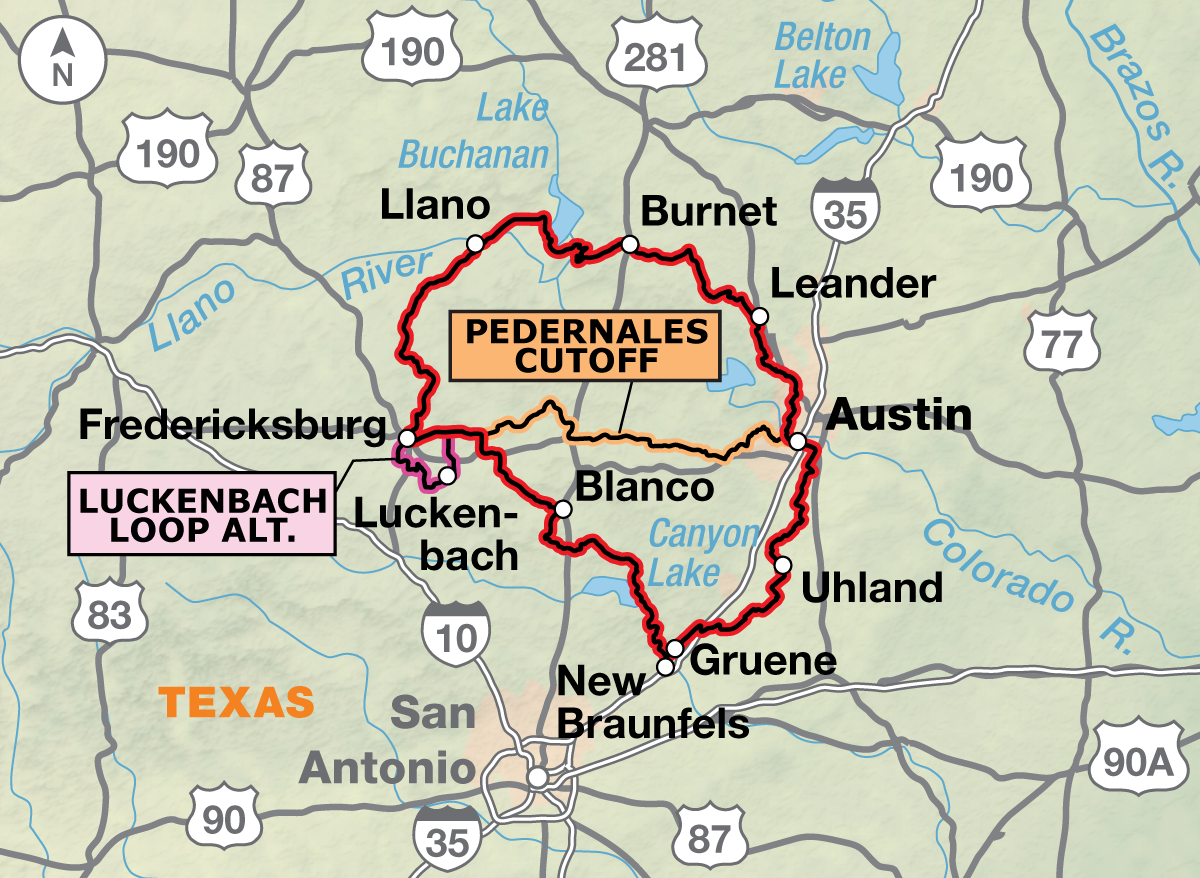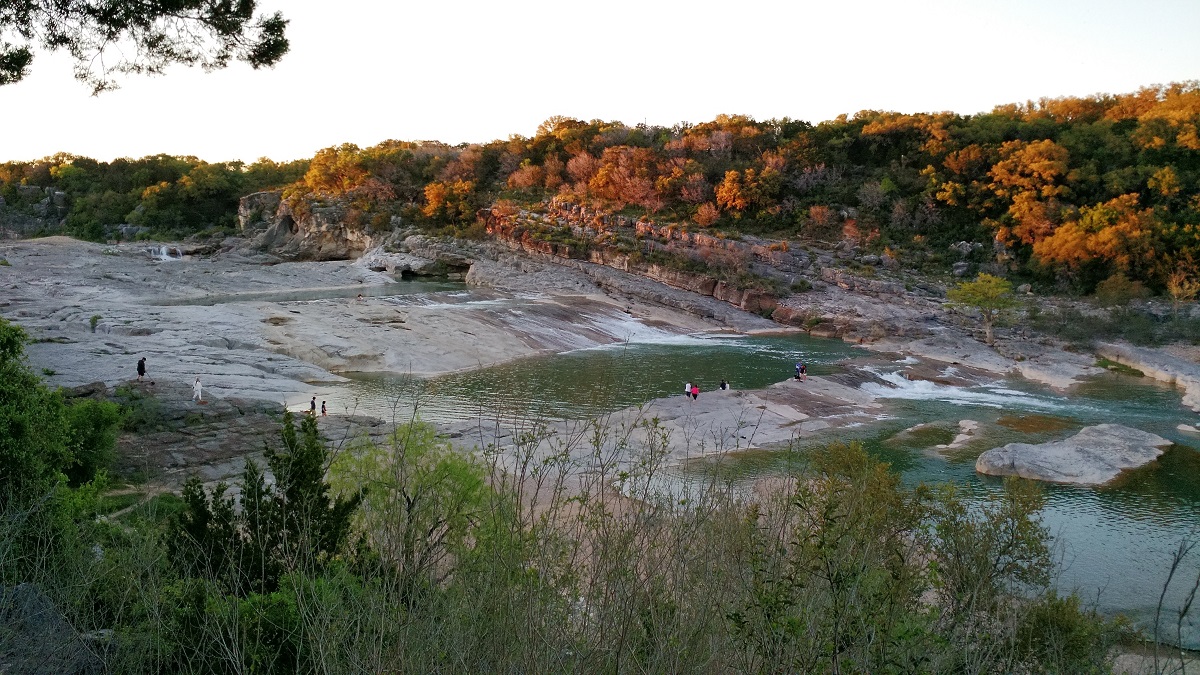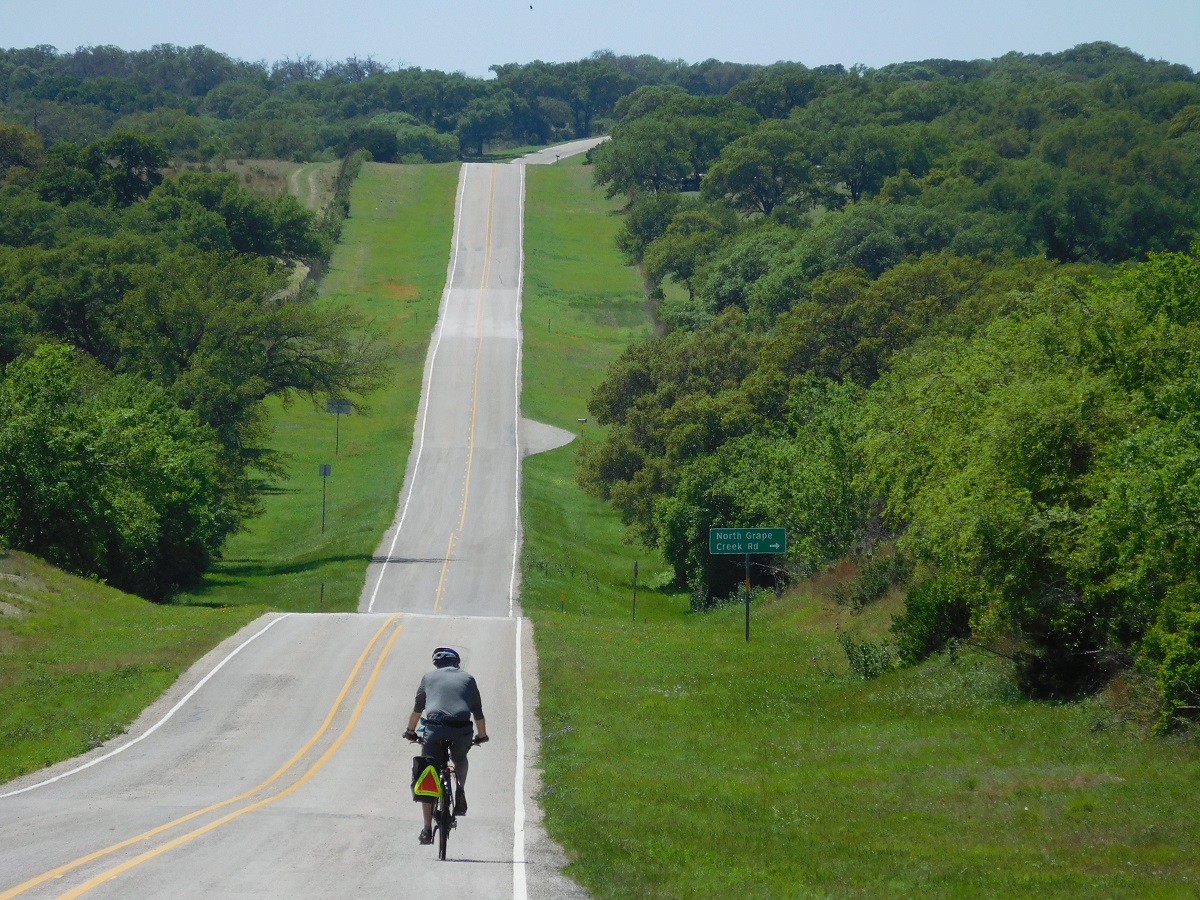Planning for the Texas Hill Country Loop [VIDEO]
The moment the first edition of the Texas Hill Country Loop map was off the press, John Koonz was on the route. As an Austin native, John has spent a lot of time riding the roads and off-the-beaten paths of Texas. By simply pedaling out of his neighborhood, he’s off on an adventure. And his familiarity with the area makes him a go-to resource for riding the Texas Hill Country Loop.
The Texas Hill Country Loop is a 311.3-mile paved route beginning and ending in Austin and includes cutoff routing in case your tour is only for a long weekend. The route is known for its spring wildflowers, historic sites, friendly towns, rivers, and state parks. While you might not think of Texas as being particularly hilly, John reminds us that the route is, in no uncertain terms, hilly.
Watch John’s overview of how to ride the Texas Hill Country Loop — complete with hazards particular to Central Texas and places of interest along the route — or keep reading for a summary of his route highlights.
Ways to Tour the Texas Hill Country Loop
With plenty of small towns with camping and accommodations along this route, you can tour it however you like.
Guided: Join experienced tour leaders and a small group of cyclists on Adventure Cycling’s extremely popular tour of the Texas Hill Country Loop.
Van-Supported: Have a friend drive along and carry your gear, meeting you at designated stops along the way.
Credit Card: Travel with just your water, clothes, and snacks, stopping along the way for food and accommodations.
Self-Supported: John’s favorite method has you carrying your house (tent) and kitchen with you wherever you go. While riding self-supported requires you to be more prepared and ready for the unexpected, it also allows you to be unfettered and spontaneous. Find a beautiful campsite or interesting museum you weren’t expecting? Go for it. You’re the captain of your own adventure.

Equipment Best Suited for the Texas Hill Country
We’re going to start sounding like a broken record here at Adventure Cycling, but even John agrees that the gear you have is the best gear to use. Don’t let gear be your limiting factor for this route. Any sort of bicycle that can carry your gear, whether that’s in a trailer, panniers, or bikepacking bags, will work for the Texas Hill Country.
Due to the hills, John prefers packing lightly in panniers rather than hauling a trailer — and this is coming from a man who loves his trailer.
For any setup you use, test out all of your equipment before you start your tour and be familiar with your bike. While small towns dot the landscape of this route, don’t expect a local bike shop except in New Braunfels, Fredericksburg, and Austin.
Spare Parts and Tools John Carries
- Tubes
- Allen keys
- Spoke replacements
- Duct tape
- Zip ties
- Chain breaker and replacement chain parts
- Derailer hanger
- Spare cables
Accommodations on this Route
Camping
If you’re from the western U.S., it may surprise you to learn that 98 percent of Texas is privately owned, except Big Bend and the state parks system, so dispersed camping is not possible. John highly recommends not attempting to stealth camp. Luckily, state parks and other camping options are common along the route.
Some campgrounds will charge a cyclist traveling alone less if they have hiker/biker sites, but often they will charge the price of a regular tent site, and that can easily be $10–$20/night. If you’re friendly and ask around, you can often get yourself invited to camp in a yard. Many small-town city parks are free to camp in.
Blanco State Park and Inks Lake State Park have nice shelters for camping, but you’ll need to reserve them ahead of time. John highly recommends overnighting in Blanco, a wonderful town with a brewery and local restaurants. Keep in mind that Inks Lake State Park is the first to close during flooding.
Warmshowers
While Austin boasts an abundance of Warmshowers hosts, there are very few as you get farther from Austin.
Hotels and Inns
You’ll find plenty of inns, hotels, and B&Bs along the route. Be sure to book your accommodations in Fredericksburg in advance, especially if there is an event in town.

Navigate the Texas Hill Country Route
Adventure Cycling has paper maps for this route.
When to Ride
March, April, and October have the best weather for riding in Texas, and in spring Texas is blanketed in wildflowers. These shoulder seasons are the best time for doing anything in Texas, so make reservations for accommodations as much as possible. When planning your tour, keep in mind that Hill Country is about 10 degrees colder than any forecast you’ll see for Austin.
How Long Does It Take?
John has ridden the entire Hill Country Loop in five days but highly recommends that you take longer, if you can, to explore the museums, small towns, and natural wonders of the area.
Fredericksburg is a favorite stopover among riders for its charm and local events at Marketplatz, a plaza located in the city center. For more information on sights to see along the route, check out the full description on the Texas Hill Country Loop route page.
Hazards to Heed
Water: Texas is a place of extremes, and finding reliable potable water for refilling your bottles can be the most difficult part of this route. John carries four water bottles on his frame and an extra Nalgene in his pannier as an emergency reserve, a total of approximately one gallon. When he dips into that reserve Nalgene, John knows he needs to find a water source ASAP.
Fire Ants: These non-native ants swarm and bite if you’re near an anthill, so know what an anthill looks like and don’t camp near them.
Scorpions: While there are no terribly dangerous scorpions in Central Texas, they are something to be aware of when putting on shoes.
Prickly Pear and Mesquite: Everything on the sides of the roads in Texas has sharp thorns. These pokies are equally bad for tires and human skin. Carry your bike rather than pushing it offroad.
Western Diamondback Rattlesnake: A common venomous snake in Texas, diamondbacks don’t always rattle and are quite well camouflaged. Be aware of where you’re stepping, don’t pick up sticks or debris with your hands, and simply leave the snakes alone if you see one.
Chip Seal: Make sure your tires are in good condition because the notorious chip seal of Texas won’t be nice to them.
Flash Floods: Streams that look tame can become incredibly strong during flooding, so don’t try to ride across them. Not only can the power of the water wash you and your bike downstream, but the roadbeds get slimy and slippery with algae. ATXfloods.com shows closed road crossings due to flash flooding. Be prepared to detour around these areas.
Culture: The farther you get into the country, the more polarized the culture and politics are. While Texas residents will give you the shirts off their backs — a ride, a place to camp, extra water and food — John suggests assuming that most people are armed and that you avoid political conversation.

Riding the Route: John’s Tips
For full route information including a narrative overview, terrain, logistics, and resources, check out the Texas Hill Country Loop Route page.
- Direction: Clockwise. John has ridden the route in both directions and recommends riding it clockwise for better road shoulders.
- Don’t pass up the taco stands.
- Try to avoid the section between New Braunfels and Canyon Lake on nice, warm weekends due to people driving, drinking, and floating the river. This section is curvy with no shoulder.
- Fischer is not a town. It’s a privately owned store, and camping is definitely not allowed.
- Don’t miss Blanco and Blanco State Park.
- Albert is not much of a town and has no place to camp.
- Fredericksburg: Tourist-friendly, lots of B&Bs. Budget Host Deluxe Inn is John’s favorite and is directly on the route. On the other side of town, Lady Bird Johnson Park has a campground with a shower. Check out one of the many local museums, and consider staying an extra day to take a lovely day ride from town.
- Crabapple Community Center and Prairie Mountain Community Center: Community centers along the route may or may not have water. John has gotten water from them in the past only to discover on his next ride that they no longer have water available.
- Bluffton Store has everything you could need.
- Lower Colorado River Authority (LCRA) has campsites and parks along the route. Some campsites are primitive and others have services.
- The last section of the route from Leander into Austin is car-heavy. John has alternatives to this section, including a train ride, on his online journal.
- Check for Map Updates and Corrections before you go.
